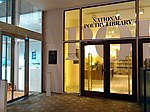Bar Topolski

Bar Topolski (previously known as the Topolski Century and Memoir of the 20th Century) is a bar and cafe in the Hungerford Bridge arches on the South Bank in London, England. Previously a gallery, it presented a large artwork by Feliks Topolski (1907–1989). In 2013, as a result of low visitor numbers and rising rents, the gallery became a bar, with some of the artwork remaining on display and the remainder being moved to a private studio.The work was started in 1975 and opened by Prince Philip, Duke of Edinburgh in 1984. It presents a panoramic view of key events and people in the 20th century. This installation forms a mural that is 600 feet (180 m) long and 12–20 feet (4–6 m) high. The artist worked on the panels from 1975 until his death.
Excerpt from the Wikipedia article Bar Topolski (License: CC BY-SA 3.0, Authors, Images).Bar Topolski
Concert Hall Approach, London Lambeth (London Borough of Lambeth)
Geographical coordinates (GPS) Address Website External links Nearby Places Show on map
Geographical coordinates (GPS)
| Latitude | Longitude |
|---|---|
| N 51.5048 ° | E -0.1157 ° |
Address
Topolski Century
Concert Hall Approach
SE1 8XU London, Lambeth (London Borough of Lambeth)
England, United Kingdom
Open on Google Maps










